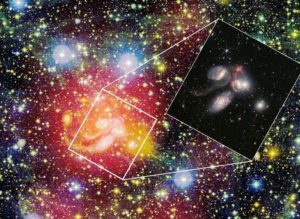
A map of the atomic hydrogen overlaid on a deep image in optical frequencies. (Image credit: CAS, NASA, ESA, CSA, and STScI)
The Five-hundred-meter Aperture Spherical radio Telescope ( FAST ) 19 beam receiver, after its full commissioning has opened up a new window into atomic gas in the universe.
Currently, FAST is the largest and most powerful single dish filled-aperture radio instrument, with a diameter of 500 metres, constructed within a natural depression in the landscape, in southwest China. The RATAN-600 in Russia has a larger aperture, but is sparsely filled. FAST has detected the largest known atomic gas structure around a galaxy group. The atomic gas structure measures at least 2 million light years across, about 20 times the size of the Milky Way, and has been discovered around the famous compact group of galaxies known as Stephan’s Quintet.
Atomic gas is the material from which all galaxies are formed. Under the influence of gravity, clouds of atomic gas clump into dust, which then accumulate and collapse into stars. The heavier elements are cooked within the hearts of stars, and released into the surrounding environment on their deaths, leading to the formation of a new generation of stars. The evolution of galaxies is mostly the conversion of atomic gas from the intergalactic medium into stars. The investigation of atomic gas is therefore crucial for the understanding of the formation and evolution of galaxies. Lead author of the paper, Xu Congsays, “This is the largest atomic gas structure ever found around a galaxy group.”
Ever since its discovery by Edouard Stephan in 1877, the well studied Stephan’s Quintet has been a laboratory for studying the process of galaxy mergers and interactions. The significance of the group was sufficient enough to be chosen as one of the first targets of the James Webb Space Telescope. The observations by FAST reveal a diffuse, low density gas away from the centre of the group, that has been there for approximately a billion years. The gas challenges conventional theories of galaxy formation and evolution, as it is not clear how the low density atomic gas can survive ionisation by the intergalactic ultraviolet background for such a long period of time. A paper describing the findings has been published in Nature.




 Driving Naari Programme launched in Chandigarh
Driving Naari Programme launched in Chandigarh






























